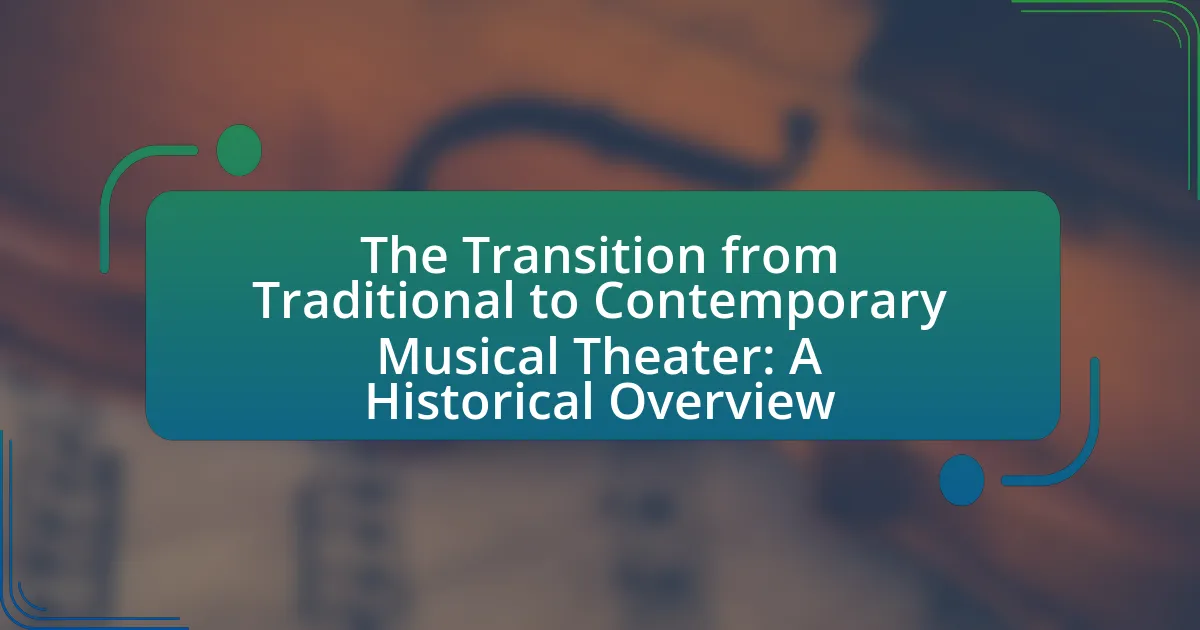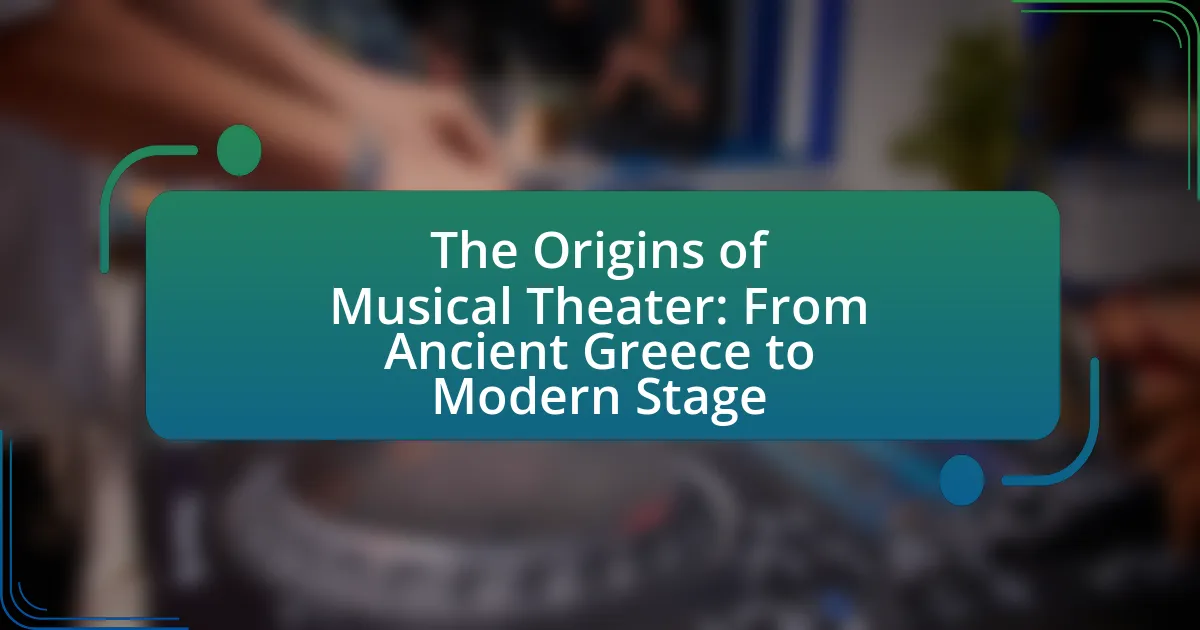The article examines the significant impact of Vaudeville on the development of musical theater, highlighting how this theatrical form introduced diverse performance styles, including comedy, music, and dance, which became essential components of modern musicals. It discusses the influence of Vaudeville’s structure on early musical theater formats, the role of performers who transitioned from Vaudeville to musical theater, and the incorporation of various acts that enriched the genre. Additionally, the article explores how the decline of Vaudeville led to a shift towards cohesive storytelling in musical theater and identifies lessons contemporary productions can learn from Vaudeville to enhance audience engagement.

What is the significance of Vaudeville in the context of musical theater?
Vaudeville significantly influenced the development of musical theater by introducing a variety of performance styles, including comedy, music, and dance, which became integral to the genre. This theatrical form, popular in the late 19th and early 20th centuries, showcased diverse acts that appealed to a wide audience, thereby shaping the structure and content of modern musicals. The incorporation of elements such as variety acts and the emphasis on entertainment value in Vaudeville laid the groundwork for the narrative and stylistic innovations seen in subsequent musical theater productions, exemplified by shows like “Show Boat” and “Oklahoma!” which integrated song and dance into cohesive storytelling.
How did Vaudeville influence the early development of musical theater?
Vaudeville significantly influenced the early development of musical theater by introducing a variety of performance styles, including comedy, music, and dance, which became integral components of musical productions. The format of vaudeville, characterized by a series of diverse acts, encouraged the blending of different entertainment forms, allowing musical theater to evolve into a more dynamic and multifaceted art form. This influence is evident in the structure of early musical theater, which often incorporated elements from vaudeville acts, such as song-and-dance routines and comedic sketches, creating a more engaging experience for audiences. The popularity of vaudeville also helped to establish a broader audience for musical theater, as it attracted diverse demographics to live performances, ultimately shaping the commercial viability and artistic direction of the genre.
What elements of Vaudeville were incorporated into musical theater productions?
Vaudeville incorporated several key elements into musical theater productions, including variety acts, comedic sketches, and musical performances. These elements allowed for a diverse range of entertainment within a single show, appealing to broad audiences. The structure of musical theater began to reflect the vaudeville format by integrating song and dance numbers with comedic interludes, creating a more dynamic and engaging theatrical experience. Historical evidence shows that the transition from vaudeville to musical theater was significant in the early 20th century, as productions like “Show Boat” and “Oklahoma!” began to blend these elements seamlessly, establishing a new genre that emphasized storytelling through music and performance.
How did the structure of Vaudeville shows shape musical theater formats?
The structure of Vaudeville shows significantly influenced musical theater formats by introducing a variety of performance styles and a focus on entertainment diversity. Vaudeville’s format included a series of short acts, such as comedy, music, and dance, which encouraged the integration of multiple genres within a single production. This approach led to the development of the musical theater format that emphasizes a blend of storytelling, song, and dance, allowing for a more dynamic and engaging audience experience. The popularity of Vaudeville in the late 19th and early 20th centuries demonstrated the effectiveness of this structure, as it attracted diverse audiences and showcased a range of talent, ultimately shaping the narrative and stylistic elements of modern musical theater.
What role did performers from Vaudeville play in musical theater?
Performers from Vaudeville significantly influenced the development of musical theater by introducing diverse entertainment styles and emphasizing variety in performances. Vaudeville acts, which included comedy, music, dance, and specialty acts, showcased a blend of talents that became integral to musical theater productions. This format encouraged the incorporation of multiple performance elements, leading to the creation of more dynamic and engaging shows. The transition of Vaudeville performers into musical theater helped to popularize the genre, as they brought with them established audiences and a rich tradition of performance that emphasized entertainment value, timing, and audience interaction.
Who were some notable Vaudeville performers that transitioned to musical theater?
Notable Vaudeville performers who transitioned to musical theater include Al Jolson, Ethel Merman, and George M. Cohan. Al Jolson, known for his powerful singing voice, became a major star in musical theater with his role in “The Jazz Singer,” which was the first significant talking picture. Ethel Merman, celebrated for her distinctive voice and commanding stage presence, starred in numerous Broadway hits such as “Anything Goes” and “Annie Get Your Gun.” George M. Cohan, a key figure in American musical theater, wrote and starred in iconic shows like “Yankee Doodle Dandy,” showcasing his talents as a performer and playwright. These performers exemplify the significant influence of Vaudeville on the evolution of musical theater.
How did their performances impact the style and presentation of musical theater?
Vaudeville performances significantly influenced the style and presentation of musical theater by introducing a variety of entertainment forms, including comedy, song, and dance, which became integral to musical productions. The incorporation of diverse acts and the emphasis on spectacle in vaudeville led to a more dynamic and engaging theatrical experience, encouraging the blending of narrative with performance elements. This shift is evidenced by the transition from traditional operettas to more varied musical formats in the early 20th century, as seen in productions like “Show Boat” (1927), which combined storytelling with musical performance, reflecting vaudeville’s impact on narrative structure and audience engagement in musical theater.

What are the key characteristics of Vaudeville that contributed to musical theater?
Vaudeville is characterized by its variety of acts, including music, dance, comedy, and specialty performances, which significantly influenced the development of musical theater. This format allowed for a diverse range of entertainment styles, encouraging the integration of different performance elements into cohesive productions. The emphasis on spectacle and audience engagement in Vaudeville paved the way for the musical theater genre to adopt similar techniques, such as elaborate staging and the inclusion of popular songs. Additionally, the use of recurring themes and character archetypes in Vaudeville acts contributed to the narrative structure of musical theater, fostering a blend of storytelling and performance that became a hallmark of the genre.
How did the variety format of Vaudeville enhance musical theater?
The variety format of Vaudeville enhanced musical theater by introducing a diverse range of acts, including music, dance, comedy, and specialty performances, which broadened the appeal and artistic scope of theatrical productions. This eclectic mix allowed for greater experimentation and innovation in storytelling and performance styles, ultimately influencing the structure and content of musical theater. Historical evidence shows that Vaudeville’s popularity in the late 19th and early 20th centuries led to the incorporation of its elements into Broadway shows, as seen in productions like “Ziegfeld Follies,” which combined various performance types into cohesive entertainment experiences.
What types of acts were common in Vaudeville that influenced musical theater?
Vaudeville commonly featured a variety of acts that significantly influenced musical theater, including musical performances, comedy sketches, dance routines, and variety acts. Musical performances often included popular songs of the time, which were later integrated into musical theater productions. Comedy sketches provided a template for the humorous dialogue and character interactions seen in musicals. Dance routines showcased choreography that would become a staple in musical theater, emphasizing the importance of movement and rhythm. Variety acts, which included everything from magic shows to acrobatics, contributed to the eclectic nature of musical theater, encouraging a blend of different performance styles. This diverse array of acts in Vaudeville laid the groundwork for the multi-faceted productions that characterize modern musical theater.
How did audience interaction in Vaudeville shape the experience of musical theater?
Audience interaction in Vaudeville significantly shaped the experience of musical theater by fostering a participatory atmosphere that encouraged direct engagement between performers and spectators. This interaction included audience responses such as laughter, applause, and heckling, which influenced the pacing and delivery of performances. Historical evidence shows that Vaudeville acts often adapted in real-time based on audience reactions, creating a dynamic environment that made each performance unique. This practice laid the groundwork for modern musical theater, where audience engagement remains a crucial element, enhancing the overall enjoyment and emotional connection to the performance.
What musical styles emerged from the Vaudeville tradition?
Musical styles that emerged from the Vaudeville tradition include ragtime, jazz, and early forms of musical theater. Ragtime, characterized by its syncopated rhythms, gained popularity in the late 19th century and was often featured in Vaudeville performances. Jazz, which evolved in the early 20th century, incorporated elements from Vaudeville acts, blending improvisation with theatrical performance. Additionally, the structure and style of early musical theater were heavily influenced by the variety acts and song-and-dance routines typical of Vaudeville, leading to the development of the American musical. These connections illustrate how Vaudeville served as a foundational platform for these musical styles, shaping the landscape of American entertainment.
How did ragtime and jazz influence the musical numbers in early musical theater?
Ragtime and jazz significantly influenced the musical numbers in early musical theater by introducing syncopated rhythms and improvisational elements that transformed traditional song structures. The incorporation of ragtime, characterized by its lively tempo and off-beat rhythms, allowed for more dynamic and engaging performances, as seen in productions like “Shuffle Along” (1921), which showcased the genre’s unique style. Jazz further expanded this influence by emphasizing individual expression and spontaneity, leading to more varied and complex musical arrangements. The blending of these genres not only enriched the musical landscape but also reflected the cultural shifts of the early 20th century, making musical theater more accessible and appealing to diverse audiences.
What role did songwriters from the Vaudeville era play in musical theater development?
Songwriters from the Vaudeville era significantly influenced the development of musical theater by integrating diverse musical styles and comedic elements into theatrical productions. Their contributions included the creation of catchy melodies and witty lyrics that appealed to a broad audience, which helped to establish the musical as a popular form of entertainment. Notably, songwriters like George M. Cohan and Irving Berlin emerged from this tradition, blending various genres such as ragtime and jazz into their works. This fusion not only enriched the musical theater repertoire but also laid the groundwork for future composers, shaping the evolution of American musical theater throughout the 20th century.

How did the decline of Vaudeville affect musical theater?
The decline of Vaudeville significantly transformed musical theater by shifting its focus from variety acts to more cohesive storytelling and character development. As Vaudeville waned in popularity during the 1930s, musical theater began to incorporate elements of drama and narrative structure, leading to the emergence of the book musical, which integrates songs and dialogue to advance the plot. This transition is evidenced by the success of shows like “Oklahoma!” in 1943, which exemplified the new format by blending music, dance, and a strong narrative, marking a departure from the episodic nature of Vaudeville performances. Consequently, the decline of Vaudeville catalyzed a more sophisticated approach to musical theater, emphasizing artistic unity and thematic depth.
What were the main factors leading to the decline of Vaudeville?
The main factors leading to the decline of Vaudeville included the rise of cinema, changing audience preferences, and the impact of the Great Depression. The emergence of motion pictures in the early 20th century provided a new form of entertainment that was more accessible and affordable, drawing audiences away from live performances. Additionally, as societal tastes evolved, audiences began to favor more cohesive narratives and musical productions, which were better represented in Broadway shows and film musicals. The economic hardships of the Great Depression further diminished disposable income for entertainment, leading to a significant reduction in theater attendance. These combined factors ultimately contributed to the decline of Vaudeville as a dominant form of entertainment in America.
How did the rise of cinema impact Vaudeville and musical theater?
The rise of cinema significantly diminished the popularity of Vaudeville and musical theater by providing audiences with a new, accessible form of entertainment. As cinema became widely available in the early 20th century, it attracted large audiences due to its ability to offer visual storytelling, sound, and special effects that live performances could not match. This shift led to a decline in Vaudeville theaters, which struggled to compete with the allure of film, resulting in many venues closing or transitioning to movie houses. Additionally, the economic pressures from the Great Depression further accelerated this decline, as audiences opted for the cheaper entertainment options that cinema provided. Consequently, while Vaudeville and musical theater influenced early cinema through their performance styles and musical numbers, the rise of cinema ultimately transformed the entertainment landscape, leading to a significant reduction in the prominence of live theatrical performances.
What adaptations did musical theater make in response to the decline of Vaudeville?
Musical theater adapted to the decline of Vaudeville by integrating more cohesive narratives and character development into performances. This shift was essential as audiences began to favor structured storytelling over the variety format of Vaudeville, which consisted of unrelated acts. The emergence of the book musical in the early 20th century exemplified this adaptation, where songs and dances were interwoven with a central plot, as seen in productions like “Show Boat” (1927) by Jerome Kern and Oscar Hammerstein II. This change reflected a broader trend in entertainment, where audiences sought deeper emotional connections and thematic coherence, leading to the establishment of musical theater as a distinct and enduring art form.
What lessons can modern musical theater learn from Vaudeville?
Modern musical theater can learn the importance of variety and audience engagement from Vaudeville. Vaudeville was characterized by its diverse range of acts, including comedy, music, and dance, which kept audiences entertained and engaged. This format encouraged performers to connect with their audience through humor and relatable content, a practice that can enhance the appeal of contemporary productions. Historical evidence shows that Vaudeville’s popularity in the early 20th century stemmed from its ability to cater to a wide demographic, demonstrating that a mix of genres and styles can attract larger audiences. By incorporating elements of variety and direct audience interaction, modern musical theater can create a more dynamic and inclusive experience.
How can contemporary productions incorporate Vaudeville elements for audience engagement?
Contemporary productions can incorporate Vaudeville elements for audience engagement by integrating variety acts, interactive performances, and humor into their shows. Variety acts, such as juggling, magic, and musical numbers, can captivate audiences by providing diverse entertainment, reminiscent of traditional Vaudeville. Interactive performances, where audience members participate in the show, enhance engagement and create a memorable experience, similar to the participatory nature of Vaudeville. Additionally, incorporating humor through witty dialogue and comedic sketches can resonate with audiences, as Vaudeville was known for its comedic elements. Historical evidence shows that Vaudeville’s popularity in the early 20th century was largely due to its ability to entertain a wide range of audiences, making these elements effective in contemporary settings.
What are some successful examples of modern musicals that draw inspiration from Vaudeville?
Successful examples of modern musicals that draw inspiration from Vaudeville include “Chicago,” “The Producers,” and “Avenue Q.” “Chicago,” which debuted in 1975, incorporates elements of vaudeville through its use of song-and-dance numbers that reflect the style and themes of the era, focusing on crime and celebrity. “The Producers,” which premiered in 2001, features a comedic approach with over-the-top performances reminiscent of vaudeville acts, emphasizing humor and spectacle. “Avenue Q,” which opened in 2003, utilizes puppetry and a variety of comedic styles that echo the eclectic nature of vaudeville performances. These musicals demonstrate the lasting influence of vaudeville on contemporary theater, showcasing its blend of entertainment, humor, and diverse performance styles.
What practical tips can be applied from Vaudeville to enhance musical theater today?
Incorporating variety acts and short performances from Vaudeville can enhance musical theater today by creating a dynamic and engaging experience for audiences. Vaudeville was characterized by its diverse range of acts, including comedy, music, and dance, which kept audiences entertained and engaged. By integrating similar variety elements, modern musical theater can attract a broader audience and maintain their interest throughout the performance. Historical evidence shows that Vaudeville’s popularity in the early 20th century stemmed from its ability to cater to diverse tastes, suggesting that a mix of genres and styles can be beneficial in contemporary productions.




